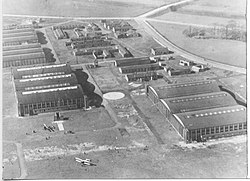Alexandra Park Aerodrome
| Alexandra Park Aerodrome | |
|---|---|

Photograph of the aerodrome in 1923 looking west over the two sets of large triple Belfast Truss hangars
|
|
| Summary | |
| Airport type | Public |
| Owner | Egerton Estate (operated post First World War by Manchester Corporation) |
| Serves | Manchester |
| Location | junction of Princess Road and Mauldeth Road West |
| Coordinates | 53°26′11″N 2°15′01″W / 53.4364°N 2.2502°WCoordinates: 53°26′11″N 2°15′01″W / 53.4364°N 2.2502°W |
| Map | |
| Location of the airport in Manchester | |
|
A grass airfield used by the military during the First World War and as a civilian airport after the war
|
|
Alexandra Park Aerodrome was the second purpose-built aerodrome in the Manchester area in England. The site was chosen by the War Department in 1917 because of its open agricultural nature, and lay between the neighbouring districts of Fallowfield, Chorlton, Whalley Range, Withington and West Didsbury, at the junction of Princess Road and Mauldeth Road West, three miles south of Manchester's city centre: the land was owned by the Egerton Estate. The aerodrome's brief existence is commemorated on a plaque in the sports pavilion at Hough End Playing Fields, which now occupy part of the site. A commemorative plaque was unveiled on 7 July 2007 to mark the 90th anniversary of the aerodrome and is located in the grounds of No. 184 (Manchester South) Squadron, Air Cadets, in Hough End Crescent.
Following the closure of the Trafford Park Aerodrome (Manchester) in 1918 after only seven years of spasmodic use, Alexandra Park Aerodrome was constructed and opened in May 1918 by the War Department for the assembly, test flying and delivery of aeroplanes for the Royal Air Force (RAF) built in the Manchester area by A. V. Roe & Company (Avro) at Newton Heath and the National Aircraft Factory No. 2 (NAF No.2) at Heaton Chapel. The aerodrome took its name from the nearby Alexandra Park railway station on the Great Central Railway branch line to Manchester Central railway station. Many aeroplanes were brought to the aerodrome in major sections by rail from Avro and NAF No.2 to the nearby station; other dismantled aeroplanes came by road. A Relief Landing Ground was designated at Turn Moss, one nautical mile to the west, in Stretford.
...
Wikipedia

